HI6091: Tom and Jerry Prints – Not the Cat and Mouse Team – Online Work Placement in Special Collections (2020)
- Elaine Harrington
- January 27, 2021
The River-side welcomes the first of two guest posts from Patrick McKee, a student on the 2019/2020 MA in Medieval History in UCC, that includes the HI6091: Skills for Medieval Historians module. Patrick previously wrote the blog post “A Safe Harbour for Ships”, part of The Mapping Cork: Trade, Culture and Politics in Late Medieval and Early Modern Ireland student exhibition hosted on The River-side.
Tom and Jerry Prints – Not the Cat and Mouse Team: A Spree through Regency and Georgian London
When we consider satirists, artists such as Hogarth and Cruikshank, and writers like Swift and Thackery come to mind. As part of my MA placement, I was given the opportunity to study a largely overlooked satirist, Pierce Egan, whose collaboration with the Cruikshank brothers and his own acerbic wit shone a light in all the corners of a rapidly expanding London of the early nineteenth-century. Egan’s satirical work Life in London was a monthly publication that ran between 1821 and 1828.
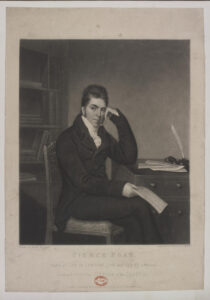
The first edition of the instantly successful Life in London or, the Day and Night Scenes of Jerry Hawthorn, Esquire, and His Elegant Friend, Corinthian Tom, Accompanied by Bob Logic, The Oxonian, in Their Rambles and Sprees through the Metropolis appeared on 15th of July 1821. The publication was dedicated to King George IV, formerly the Prince Regent.
Pierce Egan the Elder (1772-1849), the son of Irish immigrants, may have been born in London. He joined the printing trade as a compositor and established himself as one of England’s leading sports journalists. Isaac Robert Cruikshank (1789-1856) was a caricaturist, illustrator and miniaturist, he is the lesser known sibling of George Cruikshank (1792-1878), a caricaturist and book illustrator. Through George’s collaboration with Dickens, he illustrated Sketches by Boz (1836), The Mudfog Papers (1837/38) and Oliver Twist (1838).
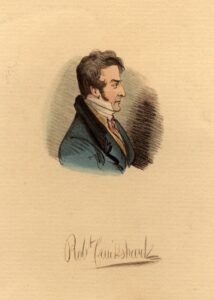
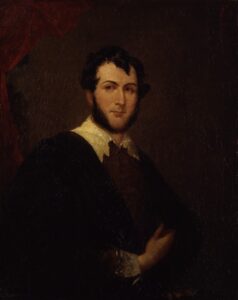
R: George Cruikshank by Unknown artist (1836). Both National Portrait Gallery, CC BY-NC-ND 3.0.
As the title indicates, Egan’s work tells the story of three ‘Gadabouts’ or ‘men about town’ or Regency Bucks: the elegant socialite Corinthian Tom, his naïve country cousin Jerry Hawthorn and their promiscuous, unscrupulous ‘friend’ Bob Logic. The three worthies may well have been caricatures made by their creator, they are shown to explore the possibilities of the high and indeed low life of 1820s London. Following a role model set by the Prince Regent, bucks of the Regency and late Georgian gentlemen gambled, drank, played hard and generally indulged in all kinds of excess. A ‘Corinthian’ was one who was both a good sportsman and took care of one’s dress. With too much money and too much time on their hands, Tom, Jerry and Logic pursue pleasure as they focus on blood sports and disguise themselves when exploring the seedier side of London. The Tom and Jerry prints included in Life in London suited the tastes of the time, a time when life in the fast lane had become a sophisticated and conscious aim.
So great was the success of the work, that the Cruikshank brothers could not colour the engravings for prints fast enough to meet the demand of the audience. Gathered into a book in 1820, the work was still in print when Queen Victoria’s long reign was coming to an end. The work was also adapted into five stage versions and inspired the fiction writing of Charles Dickens and Henry Mayhew, a founder of the satirical magazine Punch.
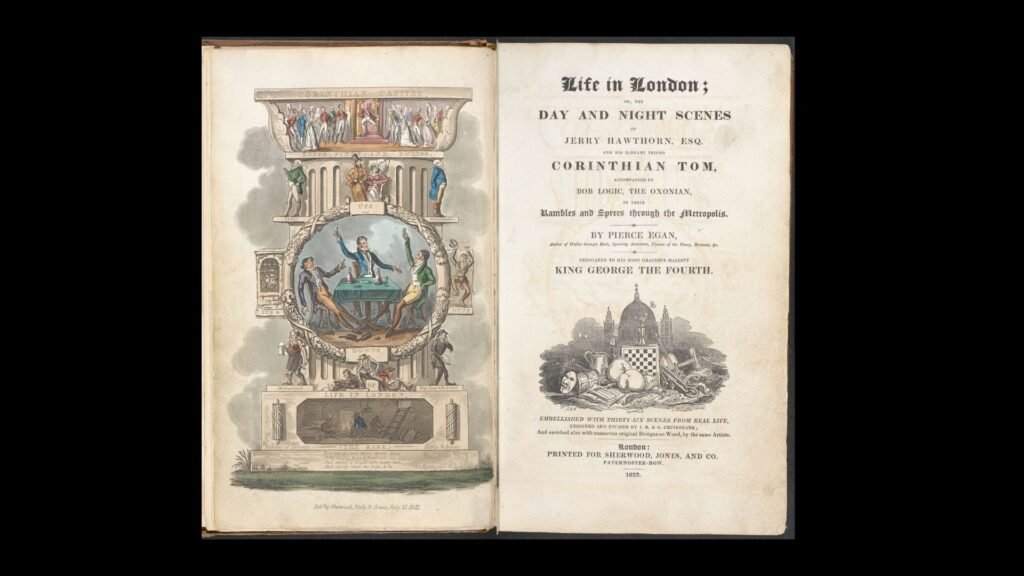
The frontispiece with a tiered structure illustrates the rigid class divide in English society. At the top sits King George IV enthroned, the lower social groups are depicted at the bottom of the image. In the centre celebrating their way of life are the three protagonists, Tom, Jerry and Logic.
The selection of prints discussed below comes from Special Collections UCC, Boole Library, University College Cork. My MA placement involved listing eleven of the thirty-five prints that appeared in Life in London and I include seven in my blog post. They mark the beginning of George Cruikshank’s first success in turning from political caricature to the drama and drollery of contemporary life.
Tom, Jerry and Logic making the most of an Evening at Vauxhall
The crowd enjoys the Vauxhall Pleasure Gardens and amusement park. This busy scene bears closer inspection. A military band plays on a raised dais, some couples are dancing. However, at the left-hand corner we see a burly man with a black eye patch. He clenches his fists, while standing over a prostrate figure of a gallant loser. The quality of the attire suggests this is a popular gathering for the appearance conscious elite and a place to be seen although, unsavoury characters also mingle there.
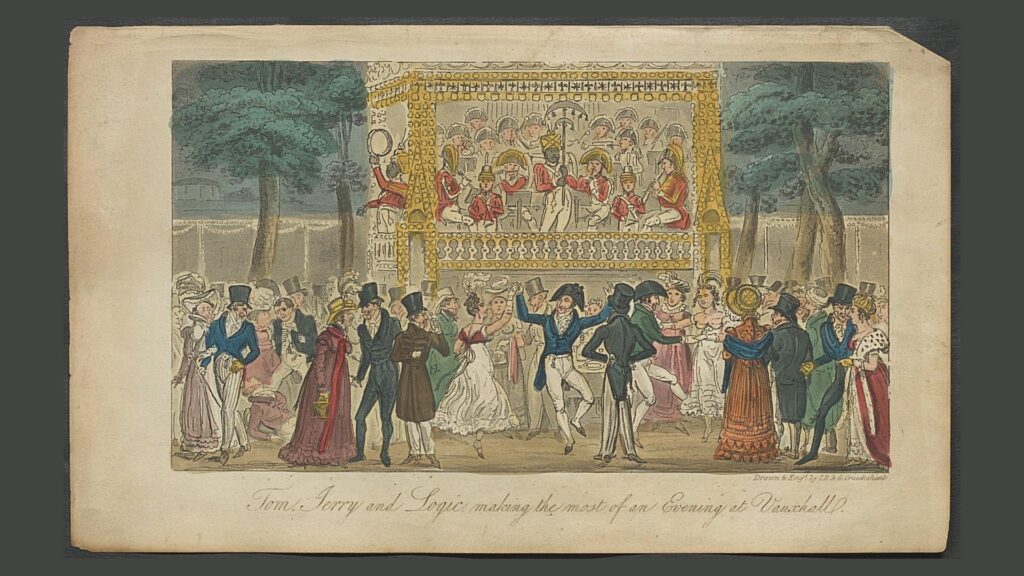
The ‘Ne Plus Ultra’ of Life in London
The Throne Room at Carlton House conveys the magnificence of royalty: crimson drapes are decorated with gold brocade, a crystal chandelier lights up the space and the monogram of George IV is seen in the background. These devices indicate the distance between royalty and a commoner. Jerry is absorbed in thought, leaning on the monarch’s seat, Tom speaks with the guide and is accompanied by Kate and Sue. Logic admires the opulence. (See Life in London, p. 261)
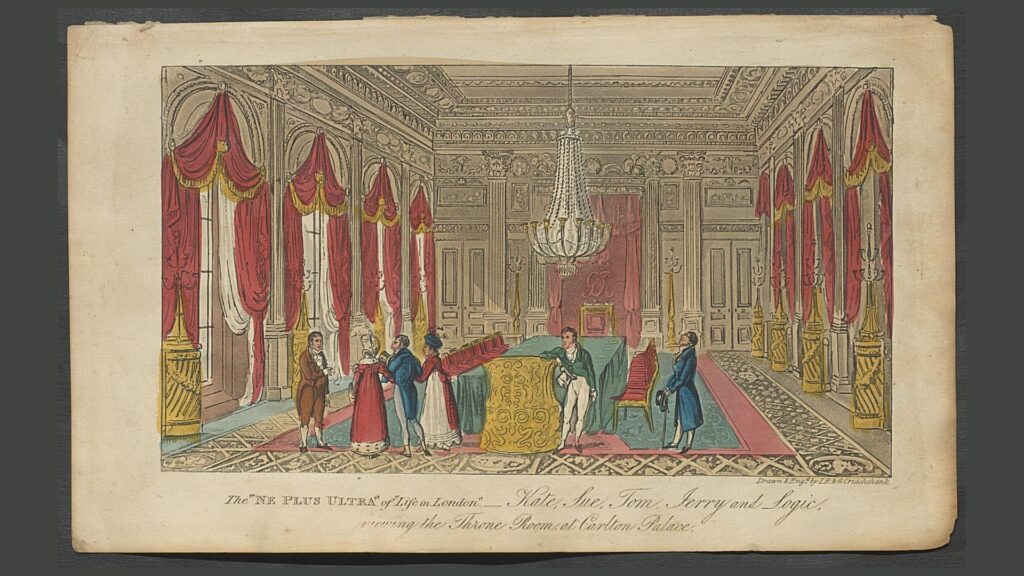
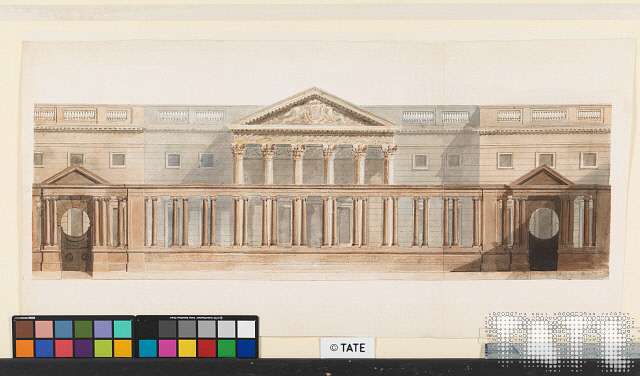
Sporting their bits of blood among the Pinks in Rotten Row
Tom is receiving a host of smiles and nods from his acquaintances when riding in Rotten Row, London’s fashionable place for horse-riding in the 18th and 19th centuries. But who is the new man next to Tom?
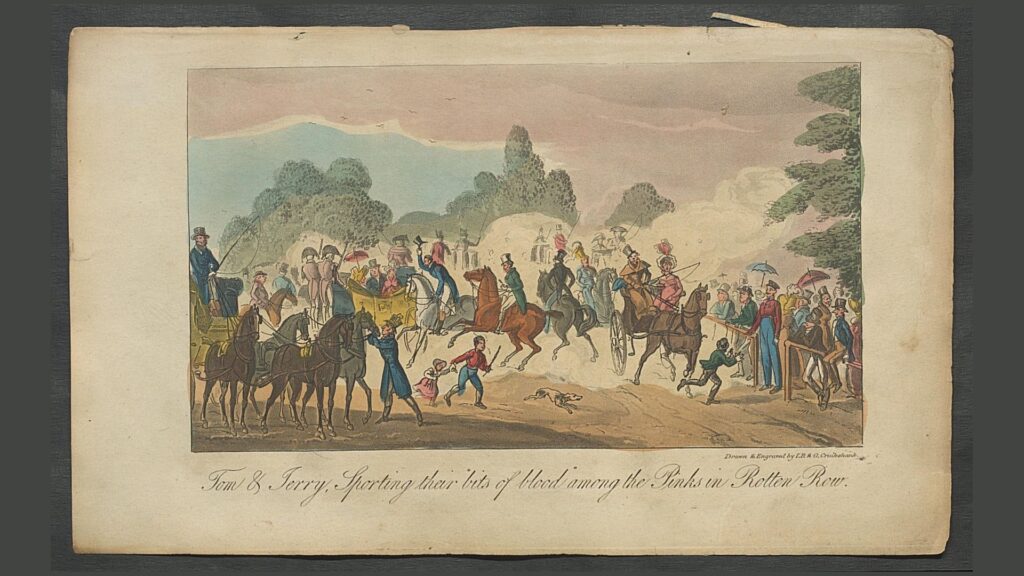
“Not of London growth”, said Lady Wanton to her sister the Hon. Miss Satire as Tom and Jerry rode by the carriage. “His ruddy, unsophisticated, huntsman’s face bespeaks him of the Tally-ho sort… he has left the rude company of horses and hounds to mix with genteel society, under the patronage of the CORINTHIAN!”.
Life in London, p. 155
These and a thousand other whisper comments and private attacks were directed at Jerry, as he passed through Rotten Row. This was another popular meeting place for upper class Londoners, where people dressed in the finest clothes in order to be seen.
A Whistling Shop
It seems from this print that Logic is in trouble for debt and living beyond his means. ‘The Fleet’ was a debtor’s prison and here Tom and Jerry sit with a dishevelled Logic. The ‘haberdasher’ serves spirits from bottles displayed on open shelves. A thin man enters the place carrying racquets. By the door, a melancholy man listens to his wife, who holds a little girl in her arms, while a little boy stares at the inmates. Some texts and prints are pasted over the fireplace, one of them showing a ship in full sail and another one a wreck.
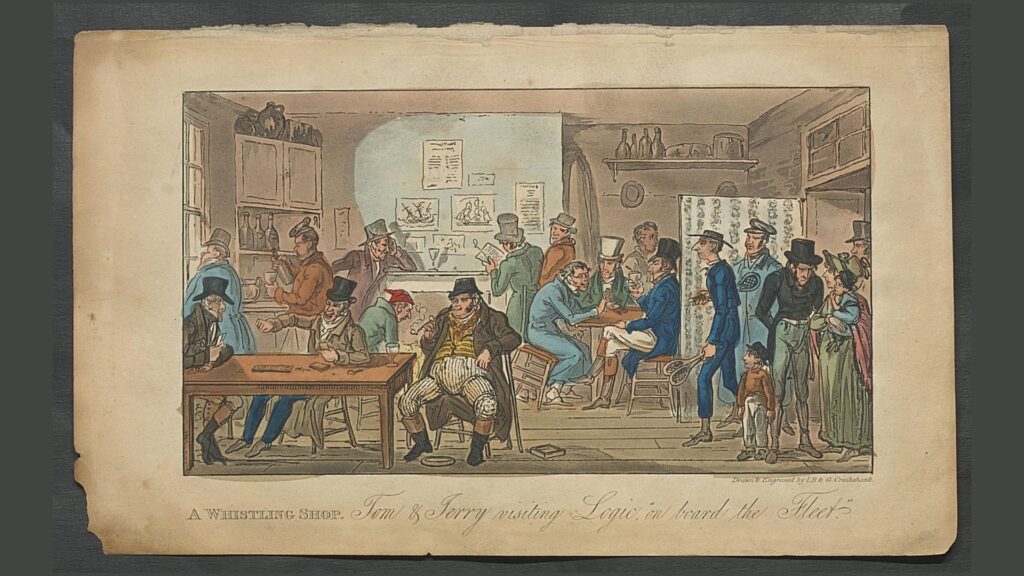
‘Masquerading it’ among the Cadgers in the ‘Back Slums’ in the Holy Land
‘The Holy Land’ was a name given to the poor rookeries (Back Slums) in the parish of St Giles in London. Tom and Jerry with Logic have disguised themselves to fit with the clientele. A drinking den is a scene of chaos. Logic stands beside Tom, wearing a bowler and carrying a crutch. Jerry chucks the chin of bare-breasted lady. Amid the bedlam, a pickpocket is a work. Look closely, this a multi-ethnic society.
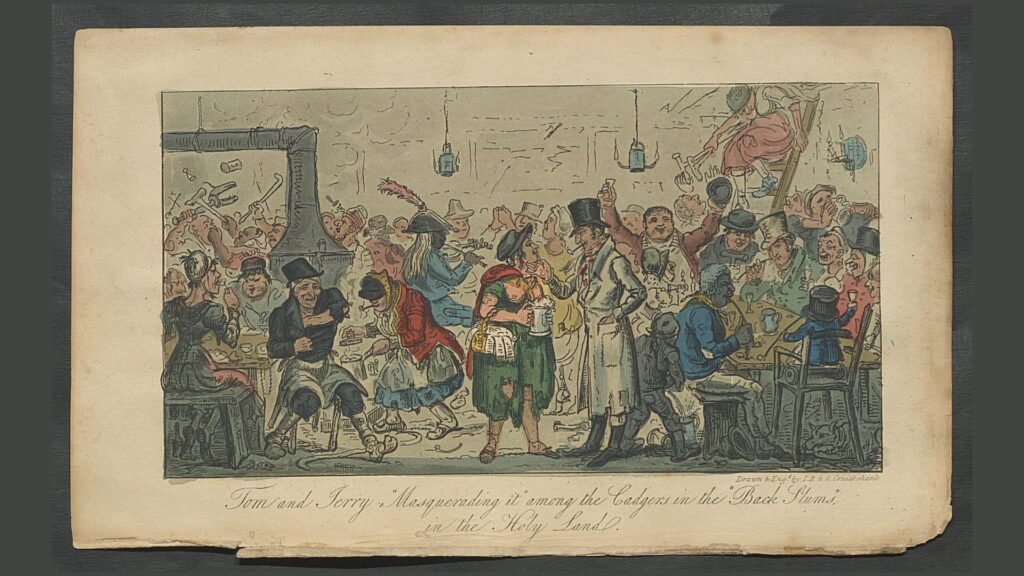
A Shilling Well Laid Out
In a room in Somerset House, a throng of people view the exhibition. The crowd inspects the pictures, while referencing their catalogues. Tom and Jerry are accompanied by the Misses Trifle: Tom and his partner sit as Jerry stands in conversation. There is a variety of society in the print, with different classes and races. An interesting figure in a conical hat and beard stands behind Jerry, in conversation with a top hatted, black spectator. The walls of the room are completely covered with paintings: the upper tier displays mainly portraits, which are quite detailed, while paintings in the lower tier are largely concealed by the crowd.
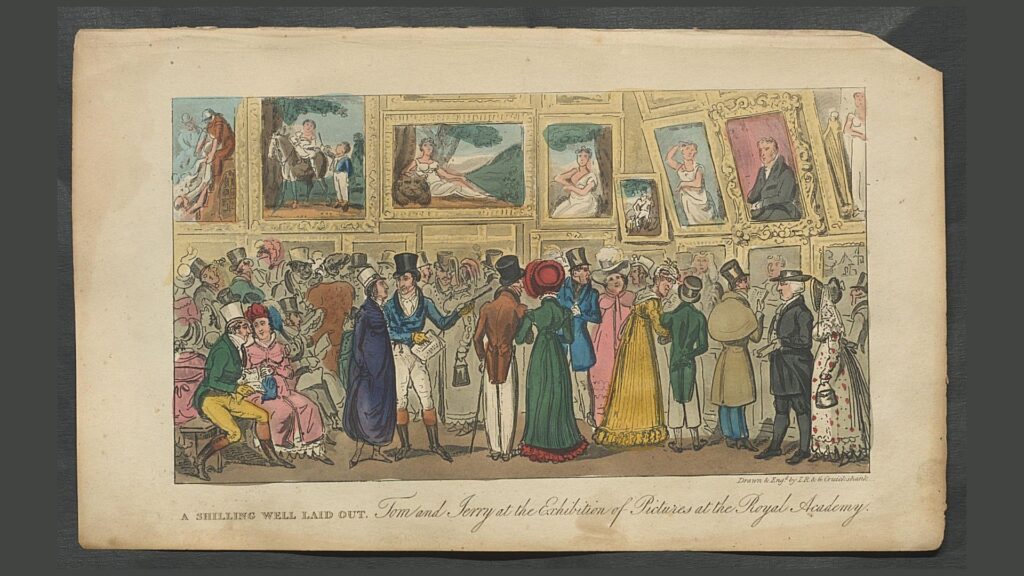
Goodbye Jerry!
Towards the end of Egan’s Life in London, there is a parting scene that takes place in the White Horse Cellar and Hatchett’s Coffee House. It is almost time for Jerry’s departure from London, but the hurly burly of the place prevents much conversation. Logic purchases a newspaper.

The separation of such staunch pals was a rather trying moment to the feelings of poor Jerry… The Corinthian caught his last sentence: “mention me in the kindest manner to the lovely Sue…I shall almost certainly return to London to enjoy a few more sprees.”
Life in London, p. 375-376.
Egan’s work was unprecedented and became instantly popular as the attraction was of course the content and its satirical style. The contrasting of scenes and characters set the misery of the poor against the profligate waste and folly of the upper classes. Egan neatly wrapped the two in attractive and animated dialogue. His sometimes hilarious and conversely dark descriptions were brought to life by the Cruikshank brothers.
Further Reading
Egan, Pierce, Finish to the Adventures of Tom, Jerry and Logic (1828)
Egan, Pierce, Life in London or, the Day and Night Scenes of Jerry Hawthorn, Esquire, and His Elegant Friend, Corinthian Tom, Accompanied by Bob Logic, The Oxonian, in Their Rambles and Sprees through the Metropolis (1821) and (1822)
Vogler, Richard A. Graphic Works of George Cruikshank: Selected and with an Introduction and Notes (1979)
